Environmental Impact Assessment: South Australia and United Kingdom
VerifiedAdded on 2020/04/21
|12
|2791
|483
Report
AI Summary
This report provides a comprehensive overview of Environmental Impact Assessment (EIA) processes, comparing the methodologies and regulatory frameworks of South Australia and the United Kingdom. The essay begins by defining EIA and outlining its procedures, including screening, scoping, information gathering, and mitigation measures. It then contrasts the EIA approaches of South Australia and the UK, highlighting the emphasis on preliminary consultation in the UK. The report further examines the EIA process in South Australia, detailing the referral, assessment, and approval stages under the EPBC Act. It also includes a case study on the environmental impact assessment of seismic operations in the Otway Basin, South Australia, discussing the potential risks and impacts on the environment, social, and economic aspects. Finally, the report provides a comparative analysis by taking another project example and comparing the two EIA process. This report offers valuable insights into the complexities of environmental impact assessment and its practical applications.
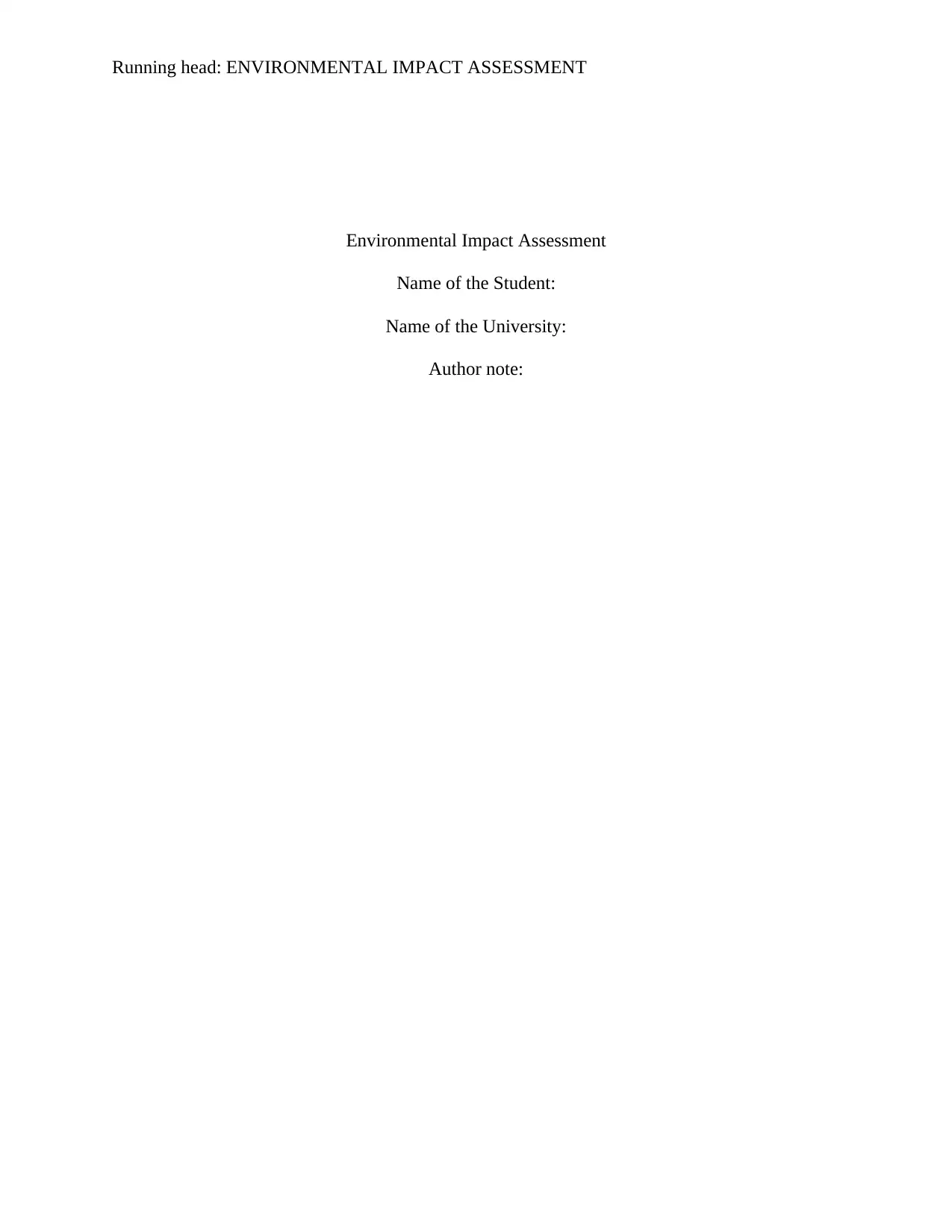
Running head: ENVIRONMENTAL IMPACT ASSESSMENT
Environmental Impact Assessment
Name of the Student:
Name of the University:
Author note:
Environmental Impact Assessment
Name of the Student:
Name of the University:
Author note:
Paraphrase This Document
Need a fresh take? Get an instant paraphrase of this document with our AI Paraphraser
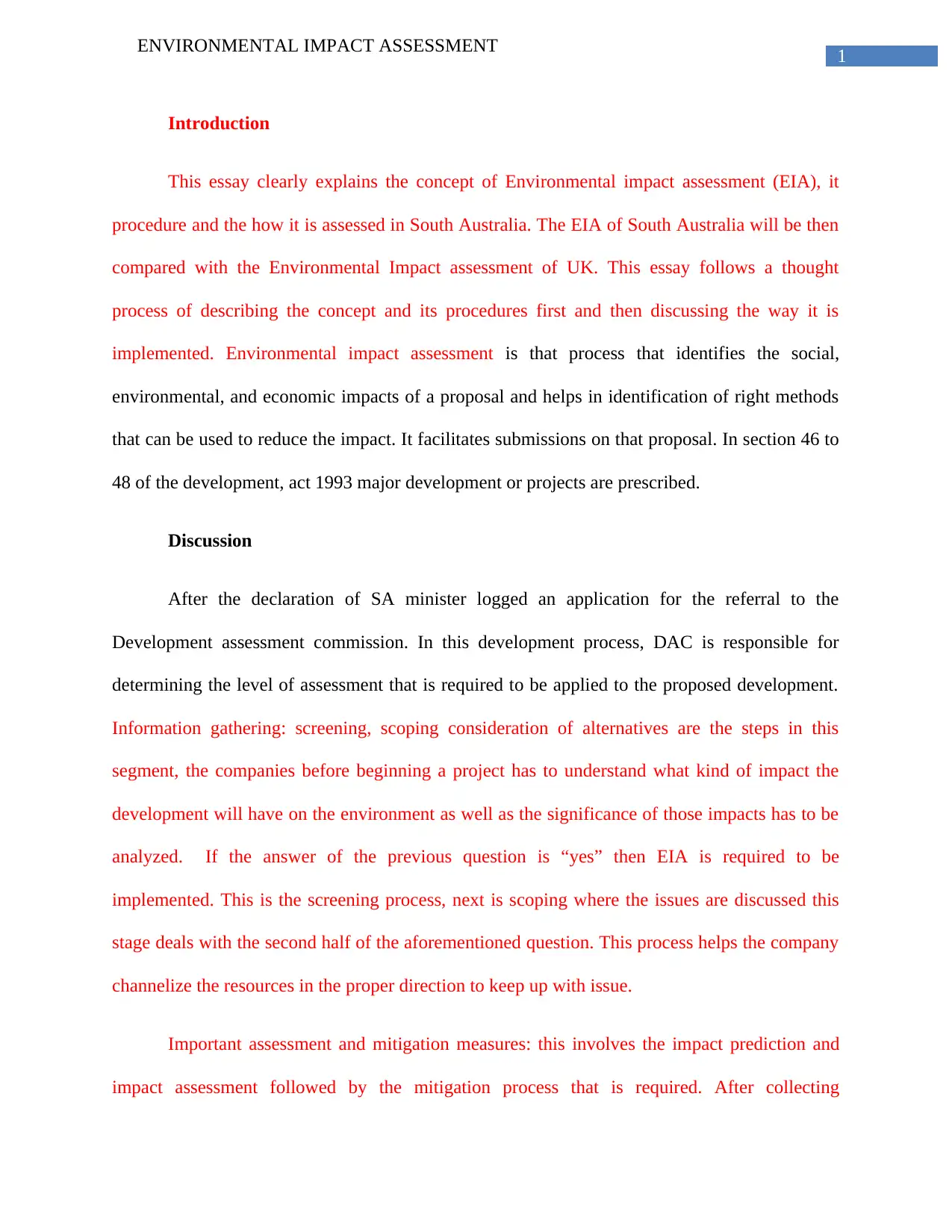
1
ENVIRONMENTAL IMPACT ASSESSMENT
Introduction
This essay clearly explains the concept of Environmental impact assessment (EIA), it
procedure and the how it is assessed in South Australia. The EIA of South Australia will be then
compared with the Environmental Impact assessment of UK. This essay follows a thought
process of describing the concept and its procedures first and then discussing the way it is
implemented. Environmental impact assessment is that process that identifies the social,
environmental, and economic impacts of a proposal and helps in identification of right methods
that can be used to reduce the impact. It facilitates submissions on that proposal. In section 46 to
48 of the development, act 1993 major development or projects are prescribed.
Discussion
After the declaration of SA minister logged an application for the referral to the
Development assessment commission. In this development process, DAC is responsible for
determining the level of assessment that is required to be applied to the proposed development.
Information gathering: screening, scoping consideration of alternatives are the steps in this
segment, the companies before beginning a project has to understand what kind of impact the
development will have on the environment as well as the significance of those impacts has to be
analyzed. If the answer of the previous question is “yes” then EIA is required to be
implemented. This is the screening process, next is scoping where the issues are discussed this
stage deals with the second half of the aforementioned question. This process helps the company
channelize the resources in the proper direction to keep up with issue.
Important assessment and mitigation measures: this involves the impact prediction and
impact assessment followed by the mitigation process that is required. After collecting
ENVIRONMENTAL IMPACT ASSESSMENT
Introduction
This essay clearly explains the concept of Environmental impact assessment (EIA), it
procedure and the how it is assessed in South Australia. The EIA of South Australia will be then
compared with the Environmental Impact assessment of UK. This essay follows a thought
process of describing the concept and its procedures first and then discussing the way it is
implemented. Environmental impact assessment is that process that identifies the social,
environmental, and economic impacts of a proposal and helps in identification of right methods
that can be used to reduce the impact. It facilitates submissions on that proposal. In section 46 to
48 of the development, act 1993 major development or projects are prescribed.
Discussion
After the declaration of SA minister logged an application for the referral to the
Development assessment commission. In this development process, DAC is responsible for
determining the level of assessment that is required to be applied to the proposed development.
Information gathering: screening, scoping consideration of alternatives are the steps in this
segment, the companies before beginning a project has to understand what kind of impact the
development will have on the environment as well as the significance of those impacts has to be
analyzed. If the answer of the previous question is “yes” then EIA is required to be
implemented. This is the screening process, next is scoping where the issues are discussed this
stage deals with the second half of the aforementioned question. This process helps the company
channelize the resources in the proper direction to keep up with issue.
Important assessment and mitigation measures: this involves the impact prediction and
impact assessment followed by the mitigation process that is required. After collecting
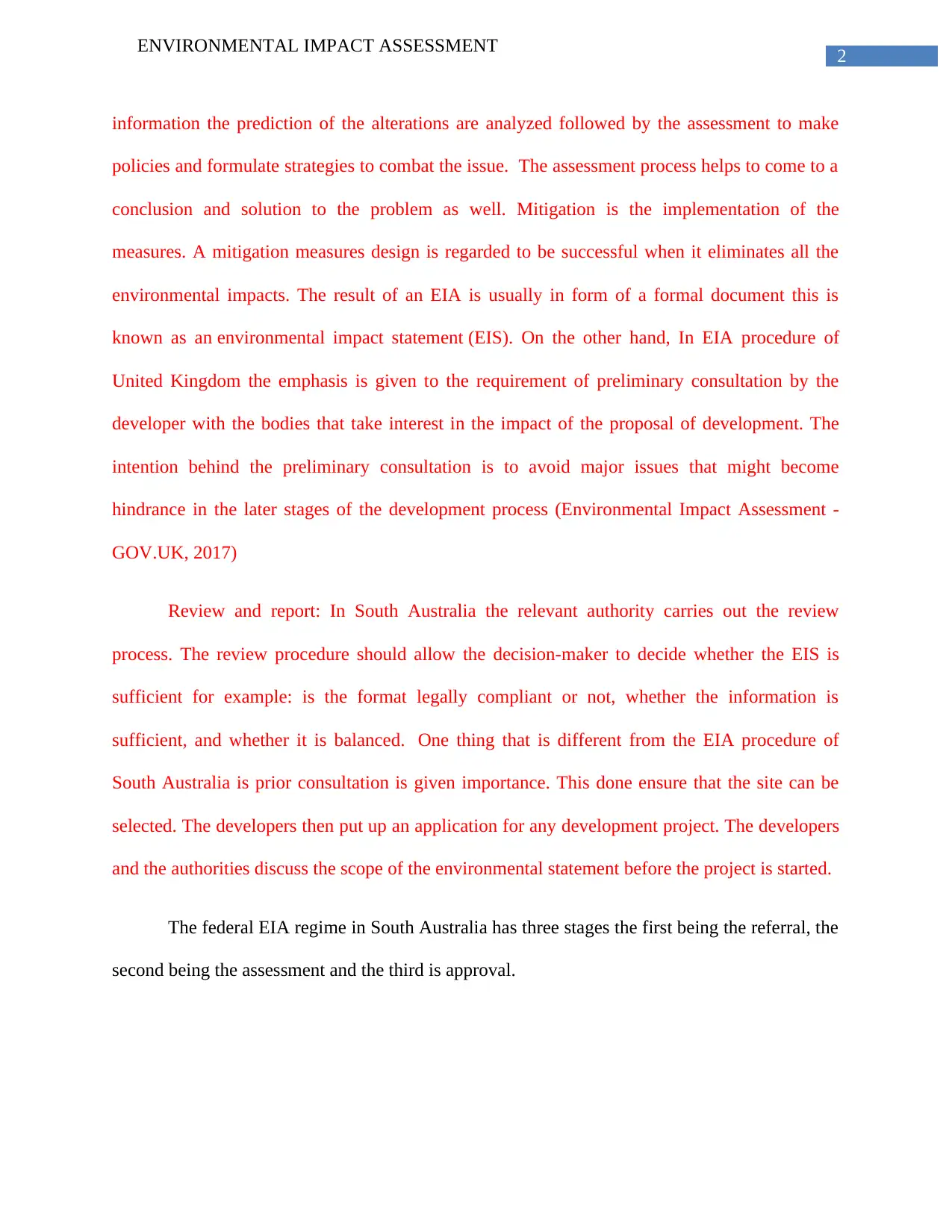
2
ENVIRONMENTAL IMPACT ASSESSMENT
information the prediction of the alterations are analyzed followed by the assessment to make
policies and formulate strategies to combat the issue. The assessment process helps to come to a
conclusion and solution to the problem as well. Mitigation is the implementation of the
measures. A mitigation measures design is regarded to be successful when it eliminates all the
environmental impacts. The result of an EIA is usually in form of a formal document this is
known as an environmental impact statement (EIS). On the other hand, In EIA procedure of
United Kingdom the emphasis is given to the requirement of preliminary consultation by the
developer with the bodies that take interest in the impact of the proposal of development. The
intention behind the preliminary consultation is to avoid major issues that might become
hindrance in the later stages of the development process (Environmental Impact Assessment -
GOV.UK, 2017)
Review and report: In South Australia the relevant authority carries out the review
process. The review procedure should allow the decision-maker to decide whether the EIS is
sufficient for example: is the format legally compliant or not, whether the information is
sufficient, and whether it is balanced. One thing that is different from the EIA procedure of
South Australia is prior consultation is given importance. This done ensure that the site can be
selected. The developers then put up an application for any development project. The developers
and the authorities discuss the scope of the environmental statement before the project is started.
The federal EIA regime in South Australia has three stages the first being the referral, the
second being the assessment and the third is approval.
ENVIRONMENTAL IMPACT ASSESSMENT
information the prediction of the alterations are analyzed followed by the assessment to make
policies and formulate strategies to combat the issue. The assessment process helps to come to a
conclusion and solution to the problem as well. Mitigation is the implementation of the
measures. A mitigation measures design is regarded to be successful when it eliminates all the
environmental impacts. The result of an EIA is usually in form of a formal document this is
known as an environmental impact statement (EIS). On the other hand, In EIA procedure of
United Kingdom the emphasis is given to the requirement of preliminary consultation by the
developer with the bodies that take interest in the impact of the proposal of development. The
intention behind the preliminary consultation is to avoid major issues that might become
hindrance in the later stages of the development process (Environmental Impact Assessment -
GOV.UK, 2017)
Review and report: In South Australia the relevant authority carries out the review
process. The review procedure should allow the decision-maker to decide whether the EIS is
sufficient for example: is the format legally compliant or not, whether the information is
sufficient, and whether it is balanced. One thing that is different from the EIA procedure of
South Australia is prior consultation is given importance. This done ensure that the site can be
selected. The developers then put up an application for any development project. The developers
and the authorities discuss the scope of the environmental statement before the project is started.
The federal EIA regime in South Australia has three stages the first being the referral, the
second being the assessment and the third is approval.
⊘ This is a preview!⊘
Do you want full access?
Subscribe today to unlock all pages.

Trusted by 1+ million students worldwide
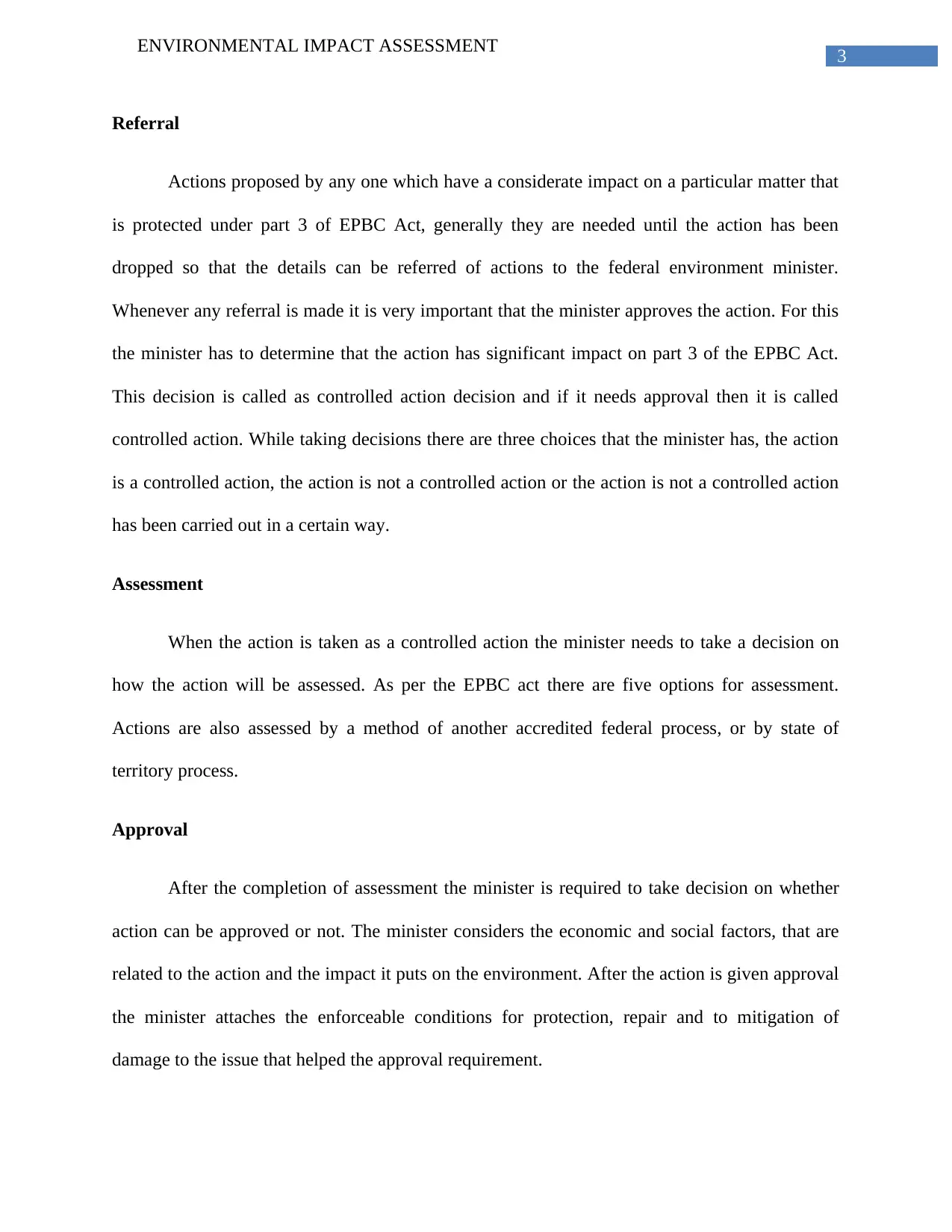
3
ENVIRONMENTAL IMPACT ASSESSMENT
Referral
Actions proposed by any one which have a considerate impact on a particular matter that
is protected under part 3 of EPBC Act, generally they are needed until the action has been
dropped so that the details can be referred of actions to the federal environment minister.
Whenever any referral is made it is very important that the minister approves the action. For this
the minister has to determine that the action has significant impact on part 3 of the EPBC Act.
This decision is called as controlled action decision and if it needs approval then it is called
controlled action. While taking decisions there are three choices that the minister has, the action
is a controlled action, the action is not a controlled action or the action is not a controlled action
has been carried out in a certain way.
Assessment
When the action is taken as a controlled action the minister needs to take a decision on
how the action will be assessed. As per the EPBC act there are five options for assessment.
Actions are also assessed by a method of another accredited federal process, or by state of
territory process.
Approval
After the completion of assessment the minister is required to take decision on whether
action can be approved or not. The minister considers the economic and social factors, that are
related to the action and the impact it puts on the environment. After the action is given approval
the minister attaches the enforceable conditions for protection, repair and to mitigation of
damage to the issue that helped the approval requirement.
ENVIRONMENTAL IMPACT ASSESSMENT
Referral
Actions proposed by any one which have a considerate impact on a particular matter that
is protected under part 3 of EPBC Act, generally they are needed until the action has been
dropped so that the details can be referred of actions to the federal environment minister.
Whenever any referral is made it is very important that the minister approves the action. For this
the minister has to determine that the action has significant impact on part 3 of the EPBC Act.
This decision is called as controlled action decision and if it needs approval then it is called
controlled action. While taking decisions there are three choices that the minister has, the action
is a controlled action, the action is not a controlled action or the action is not a controlled action
has been carried out in a certain way.
Assessment
When the action is taken as a controlled action the minister needs to take a decision on
how the action will be assessed. As per the EPBC act there are five options for assessment.
Actions are also assessed by a method of another accredited federal process, or by state of
territory process.
Approval
After the completion of assessment the minister is required to take decision on whether
action can be approved or not. The minister considers the economic and social factors, that are
related to the action and the impact it puts on the environment. After the action is given approval
the minister attaches the enforceable conditions for protection, repair and to mitigation of
damage to the issue that helped the approval requirement.
Paraphrase This Document
Need a fresh take? Get an instant paraphrase of this document with our AI Paraphraser
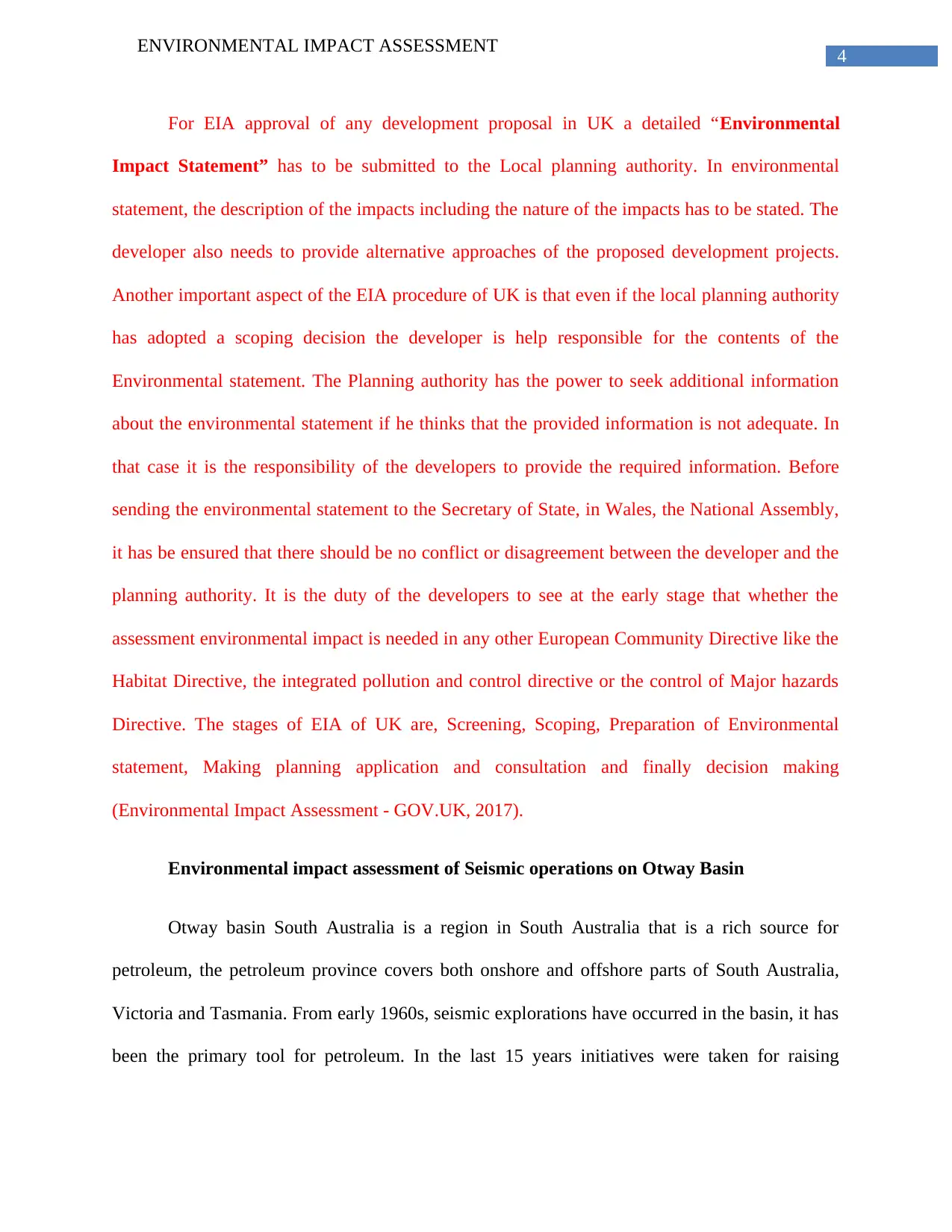
4
ENVIRONMENTAL IMPACT ASSESSMENT
For EIA approval of any development proposal in UK a detailed “Environmental
Impact Statement” has to be submitted to the Local planning authority. In environmental
statement, the description of the impacts including the nature of the impacts has to be stated. The
developer also needs to provide alternative approaches of the proposed development projects.
Another important aspect of the EIA procedure of UK is that even if the local planning authority
has adopted a scoping decision the developer is help responsible for the contents of the
Environmental statement. The Planning authority has the power to seek additional information
about the environmental statement if he thinks that the provided information is not adequate. In
that case it is the responsibility of the developers to provide the required information. Before
sending the environmental statement to the Secretary of State, in Wales, the National Assembly,
it has be ensured that there should be no conflict or disagreement between the developer and the
planning authority. It is the duty of the developers to see at the early stage that whether the
assessment environmental impact is needed in any other European Community Directive like the
Habitat Directive, the integrated pollution and control directive or the control of Major hazards
Directive. The stages of EIA of UK are, Screening, Scoping, Preparation of Environmental
statement, Making planning application and consultation and finally decision making
(Environmental Impact Assessment - GOV.UK, 2017).
Environmental impact assessment of Seismic operations on Otway Basin
Otway basin South Australia is a region in South Australia that is a rich source for
petroleum, the petroleum province covers both onshore and offshore parts of South Australia,
Victoria and Tasmania. From early 1960s, seismic explorations have occurred in the basin, it has
been the primary tool for petroleum. In the last 15 years initiatives were taken for raising
ENVIRONMENTAL IMPACT ASSESSMENT
For EIA approval of any development proposal in UK a detailed “Environmental
Impact Statement” has to be submitted to the Local planning authority. In environmental
statement, the description of the impacts including the nature of the impacts has to be stated. The
developer also needs to provide alternative approaches of the proposed development projects.
Another important aspect of the EIA procedure of UK is that even if the local planning authority
has adopted a scoping decision the developer is help responsible for the contents of the
Environmental statement. The Planning authority has the power to seek additional information
about the environmental statement if he thinks that the provided information is not adequate. In
that case it is the responsibility of the developers to provide the required information. Before
sending the environmental statement to the Secretary of State, in Wales, the National Assembly,
it has be ensured that there should be no conflict or disagreement between the developer and the
planning authority. It is the duty of the developers to see at the early stage that whether the
assessment environmental impact is needed in any other European Community Directive like the
Habitat Directive, the integrated pollution and control directive or the control of Major hazards
Directive. The stages of EIA of UK are, Screening, Scoping, Preparation of Environmental
statement, Making planning application and consultation and finally decision making
(Environmental Impact Assessment - GOV.UK, 2017).
Environmental impact assessment of Seismic operations on Otway Basin
Otway basin South Australia is a region in South Australia that is a rich source for
petroleum, the petroleum province covers both onshore and offshore parts of South Australia,
Victoria and Tasmania. From early 1960s, seismic explorations have occurred in the basin, it has
been the primary tool for petroleum. In the last 15 years initiatives were taken for raising
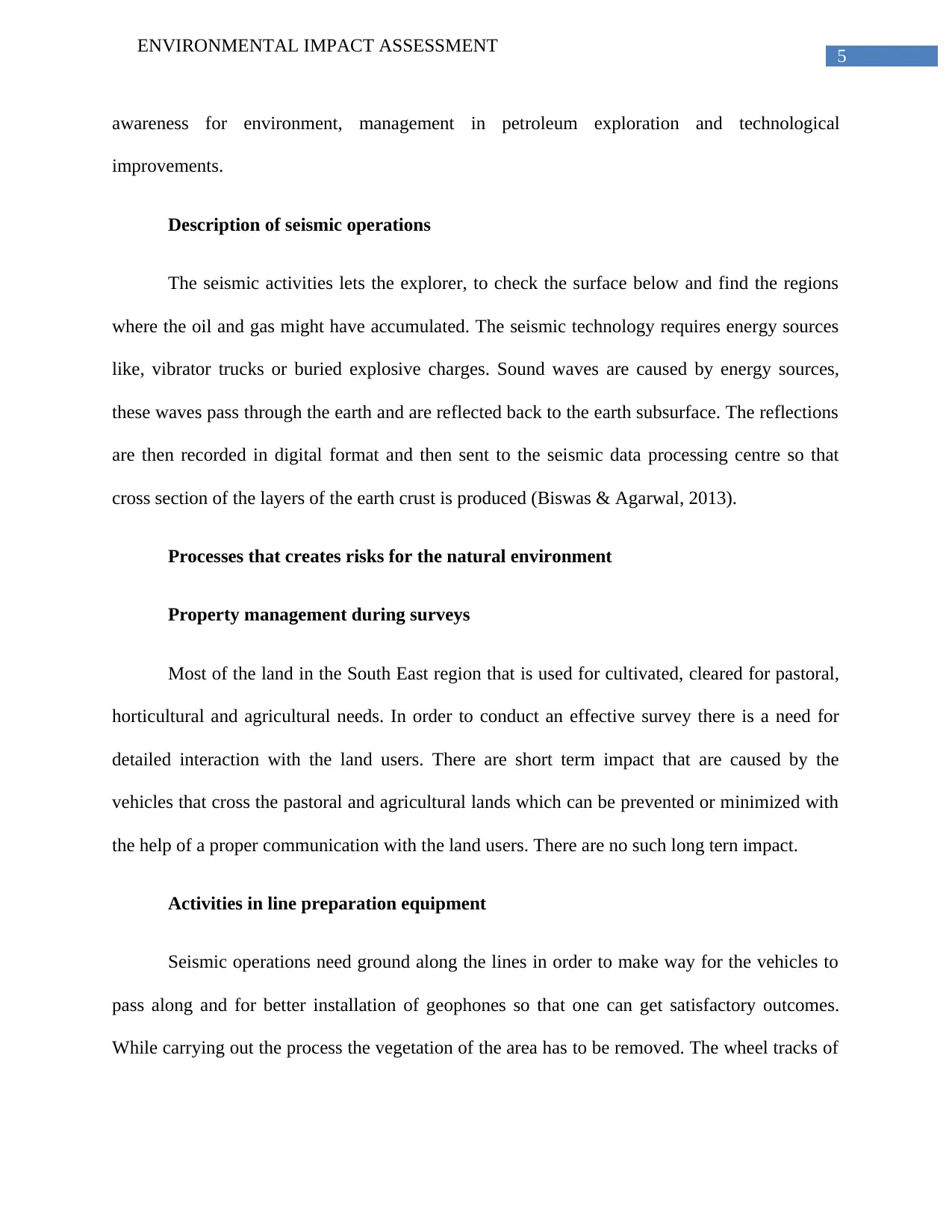
5
ENVIRONMENTAL IMPACT ASSESSMENT
awareness for environment, management in petroleum exploration and technological
improvements.
Description of seismic operations
The seismic activities lets the explorer, to check the surface below and find the regions
where the oil and gas might have accumulated. The seismic technology requires energy sources
like, vibrator trucks or buried explosive charges. Sound waves are caused by energy sources,
these waves pass through the earth and are reflected back to the earth subsurface. The reflections
are then recorded in digital format and then sent to the seismic data processing centre so that
cross section of the layers of the earth crust is produced (Biswas & Agarwal, 2013).
Processes that creates risks for the natural environment
Property management during surveys
Most of the land in the South East region that is used for cultivated, cleared for pastoral,
horticultural and agricultural needs. In order to conduct an effective survey there is a need for
detailed interaction with the land users. There are short term impact that are caused by the
vehicles that cross the pastoral and agricultural lands which can be prevented or minimized with
the help of a proper communication with the land users. There are no such long tern impact.
Activities in line preparation equipment
Seismic operations need ground along the lines in order to make way for the vehicles to
pass along and for better installation of geophones so that one can get satisfactory outcomes.
While carrying out the process the vegetation of the area has to be removed. The wheel tracks of
ENVIRONMENTAL IMPACT ASSESSMENT
awareness for environment, management in petroleum exploration and technological
improvements.
Description of seismic operations
The seismic activities lets the explorer, to check the surface below and find the regions
where the oil and gas might have accumulated. The seismic technology requires energy sources
like, vibrator trucks or buried explosive charges. Sound waves are caused by energy sources,
these waves pass through the earth and are reflected back to the earth subsurface. The reflections
are then recorded in digital format and then sent to the seismic data processing centre so that
cross section of the layers of the earth crust is produced (Biswas & Agarwal, 2013).
Processes that creates risks for the natural environment
Property management during surveys
Most of the land in the South East region that is used for cultivated, cleared for pastoral,
horticultural and agricultural needs. In order to conduct an effective survey there is a need for
detailed interaction with the land users. There are short term impact that are caused by the
vehicles that cross the pastoral and agricultural lands which can be prevented or minimized with
the help of a proper communication with the land users. There are no such long tern impact.
Activities in line preparation equipment
Seismic operations need ground along the lines in order to make way for the vehicles to
pass along and for better installation of geophones so that one can get satisfactory outcomes.
While carrying out the process the vegetation of the area has to be removed. The wheel tracks of
⊘ This is a preview!⊘
Do you want full access?
Subscribe today to unlock all pages.

Trusted by 1+ million students worldwide
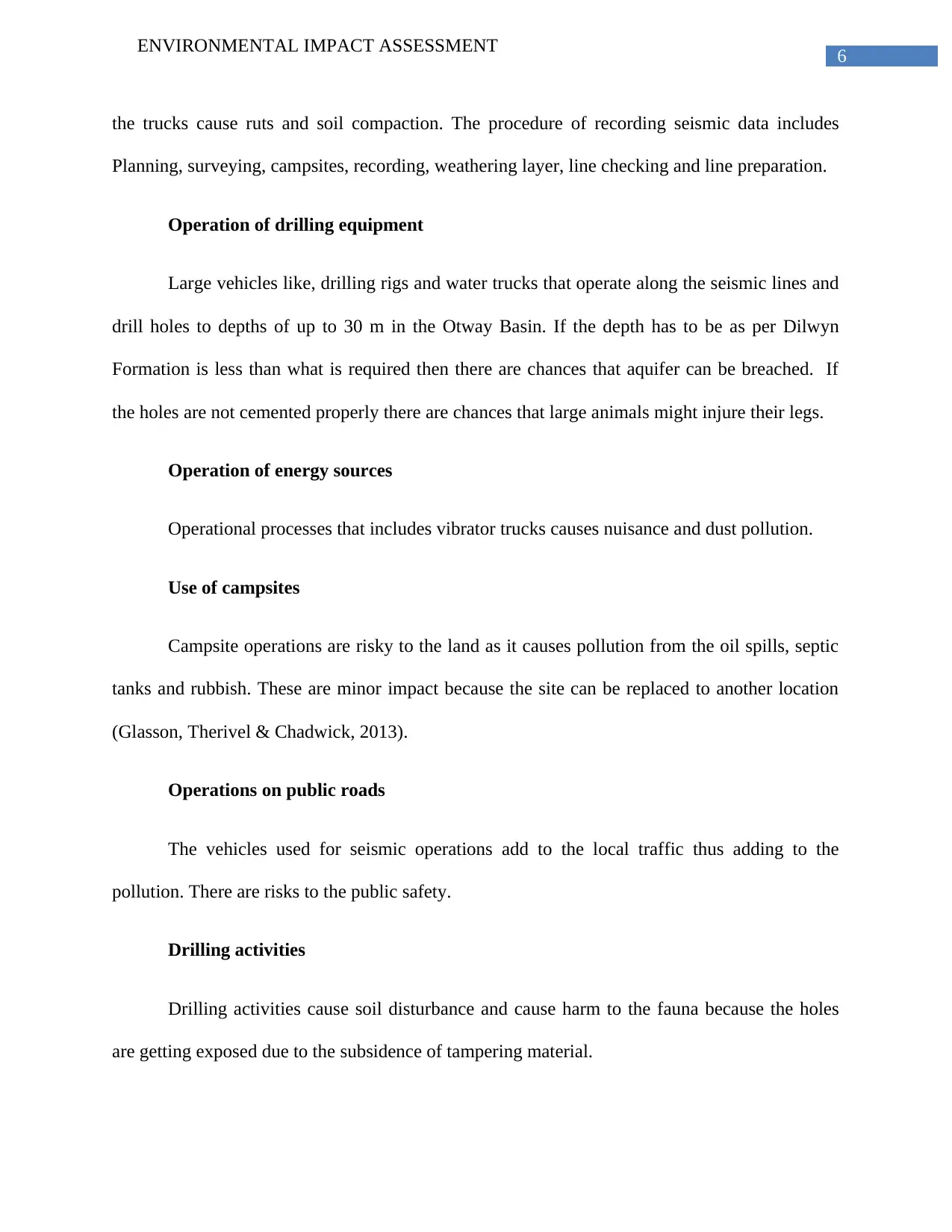
6
ENVIRONMENTAL IMPACT ASSESSMENT
the trucks cause ruts and soil compaction. The procedure of recording seismic data includes
Planning, surveying, campsites, recording, weathering layer, line checking and line preparation.
Operation of drilling equipment
Large vehicles like, drilling rigs and water trucks that operate along the seismic lines and
drill holes to depths of up to 30 m in the Otway Basin. If the depth has to be as per Dilwyn
Formation is less than what is required then there are chances that aquifer can be breached. If
the holes are not cemented properly there are chances that large animals might injure their legs.
Operation of energy sources
Operational processes that includes vibrator trucks causes nuisance and dust pollution.
Use of campsites
Campsite operations are risky to the land as it causes pollution from the oil spills, septic
tanks and rubbish. These are minor impact because the site can be replaced to another location
(Glasson, Therivel & Chadwick, 2013).
Operations on public roads
The vehicles used for seismic operations add to the local traffic thus adding to the
pollution. There are risks to the public safety.
Drilling activities
Drilling activities cause soil disturbance and cause harm to the fauna because the holes
are getting exposed due to the subsidence of tampering material.
ENVIRONMENTAL IMPACT ASSESSMENT
the trucks cause ruts and soil compaction. The procedure of recording seismic data includes
Planning, surveying, campsites, recording, weathering layer, line checking and line preparation.
Operation of drilling equipment
Large vehicles like, drilling rigs and water trucks that operate along the seismic lines and
drill holes to depths of up to 30 m in the Otway Basin. If the depth has to be as per Dilwyn
Formation is less than what is required then there are chances that aquifer can be breached. If
the holes are not cemented properly there are chances that large animals might injure their legs.
Operation of energy sources
Operational processes that includes vibrator trucks causes nuisance and dust pollution.
Use of campsites
Campsite operations are risky to the land as it causes pollution from the oil spills, septic
tanks and rubbish. These are minor impact because the site can be replaced to another location
(Glasson, Therivel & Chadwick, 2013).
Operations on public roads
The vehicles used for seismic operations add to the local traffic thus adding to the
pollution. There are risks to the public safety.
Drilling activities
Drilling activities cause soil disturbance and cause harm to the fauna because the holes
are getting exposed due to the subsidence of tampering material.
Paraphrase This Document
Need a fresh take? Get an instant paraphrase of this document with our AI Paraphraser
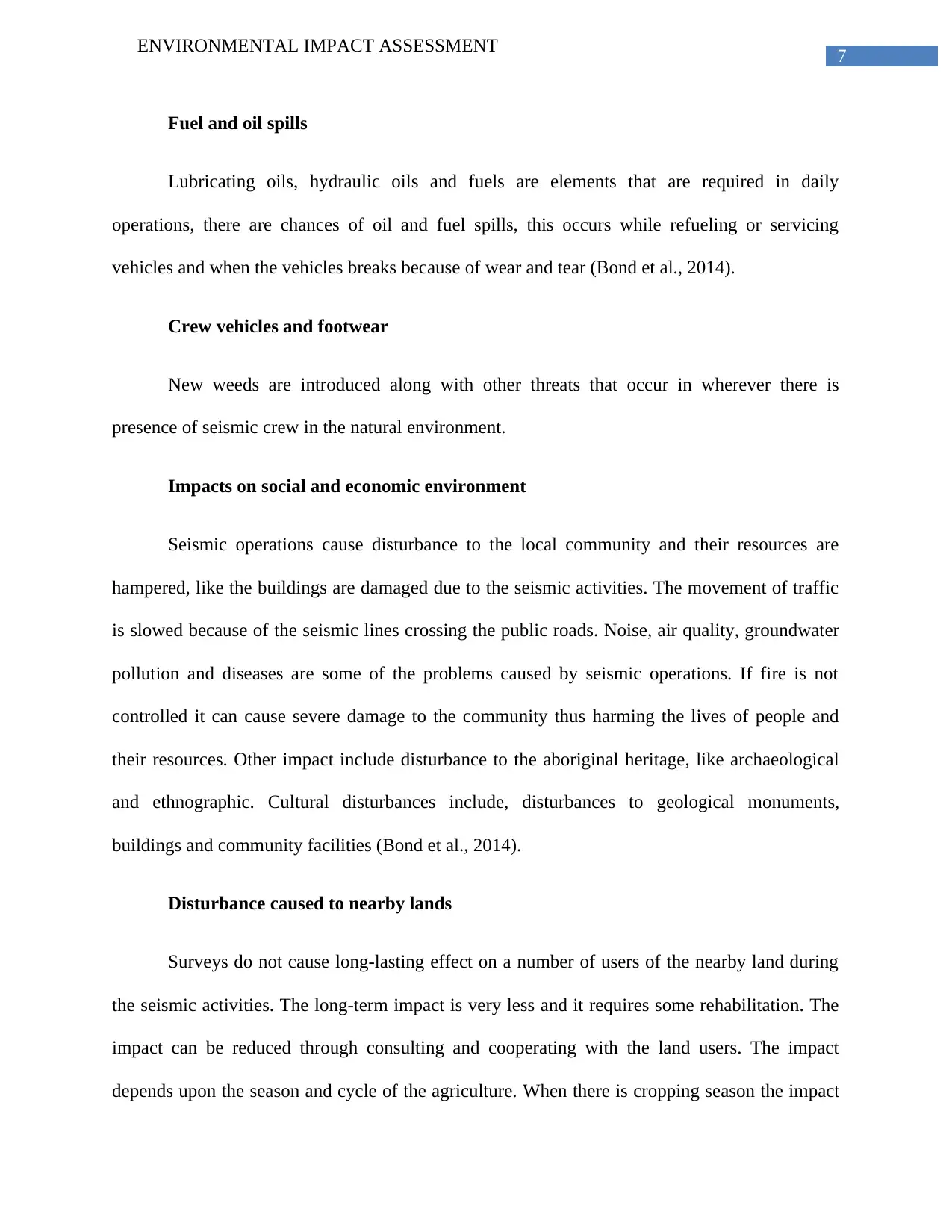
7
ENVIRONMENTAL IMPACT ASSESSMENT
Fuel and oil spills
Lubricating oils, hydraulic oils and fuels are elements that are required in daily
operations, there are chances of oil and fuel spills, this occurs while refueling or servicing
vehicles and when the vehicles breaks because of wear and tear (Bond et al., 2014).
Crew vehicles and footwear
New weeds are introduced along with other threats that occur in wherever there is
presence of seismic crew in the natural environment.
Impacts on social and economic environment
Seismic operations cause disturbance to the local community and their resources are
hampered, like the buildings are damaged due to the seismic activities. The movement of traffic
is slowed because of the seismic lines crossing the public roads. Noise, air quality, groundwater
pollution and diseases are some of the problems caused by seismic operations. If fire is not
controlled it can cause severe damage to the community thus harming the lives of people and
their resources. Other impact include disturbance to the aboriginal heritage, like archaeological
and ethnographic. Cultural disturbances include, disturbances to geological monuments,
buildings and community facilities (Bond et al., 2014).
Disturbance caused to nearby lands
Surveys do not cause long-lasting effect on a number of users of the nearby land during
the seismic activities. The long-term impact is very less and it requires some rehabilitation. The
impact can be reduced through consulting and cooperating with the land users. The impact
depends upon the season and cycle of the agriculture. When there is cropping season the impact
ENVIRONMENTAL IMPACT ASSESSMENT
Fuel and oil spills
Lubricating oils, hydraulic oils and fuels are elements that are required in daily
operations, there are chances of oil and fuel spills, this occurs while refueling or servicing
vehicles and when the vehicles breaks because of wear and tear (Bond et al., 2014).
Crew vehicles and footwear
New weeds are introduced along with other threats that occur in wherever there is
presence of seismic crew in the natural environment.
Impacts on social and economic environment
Seismic operations cause disturbance to the local community and their resources are
hampered, like the buildings are damaged due to the seismic activities. The movement of traffic
is slowed because of the seismic lines crossing the public roads. Noise, air quality, groundwater
pollution and diseases are some of the problems caused by seismic operations. If fire is not
controlled it can cause severe damage to the community thus harming the lives of people and
their resources. Other impact include disturbance to the aboriginal heritage, like archaeological
and ethnographic. Cultural disturbances include, disturbances to geological monuments,
buildings and community facilities (Bond et al., 2014).
Disturbance caused to nearby lands
Surveys do not cause long-lasting effect on a number of users of the nearby land during
the seismic activities. The long-term impact is very less and it requires some rehabilitation. The
impact can be reduced through consulting and cooperating with the land users. The impact
depends upon the season and cycle of the agriculture. When there is cropping season the impact
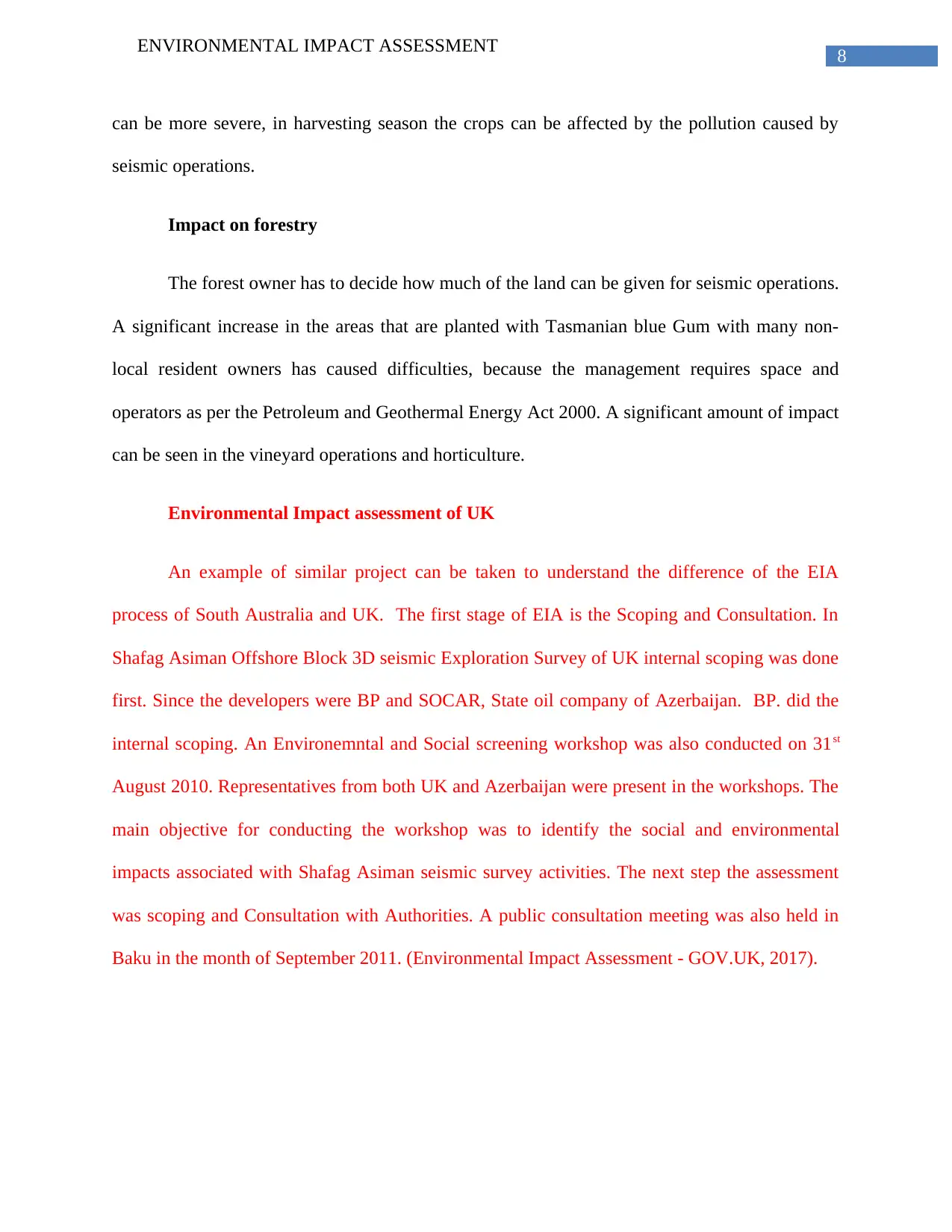
8
ENVIRONMENTAL IMPACT ASSESSMENT
can be more severe, in harvesting season the crops can be affected by the pollution caused by
seismic operations.
Impact on forestry
The forest owner has to decide how much of the land can be given for seismic operations.
A significant increase in the areas that are planted with Tasmanian blue Gum with many non-
local resident owners has caused difficulties, because the management requires space and
operators as per the Petroleum and Geothermal Energy Act 2000. A significant amount of impact
can be seen in the vineyard operations and horticulture.
Environmental Impact assessment of UK
An example of similar project can be taken to understand the difference of the EIA
process of South Australia and UK. The first stage of EIA is the Scoping and Consultation. In
Shafag Asiman Offshore Block 3D seismic Exploration Survey of UK internal scoping was done
first. Since the developers were BP and SOCAR, State oil company of Azerbaijan. BP. did the
internal scoping. An Environemntal and Social screening workshop was also conducted on 31st
August 2010. Representatives from both UK and Azerbaijan were present in the workshops. The
main objective for conducting the workshop was to identify the social and environmental
impacts associated with Shafag Asiman seismic survey activities. The next step the assessment
was scoping and Consultation with Authorities. A public consultation meeting was also held in
Baku in the month of September 2011. (Environmental Impact Assessment - GOV.UK, 2017).
ENVIRONMENTAL IMPACT ASSESSMENT
can be more severe, in harvesting season the crops can be affected by the pollution caused by
seismic operations.
Impact on forestry
The forest owner has to decide how much of the land can be given for seismic operations.
A significant increase in the areas that are planted with Tasmanian blue Gum with many non-
local resident owners has caused difficulties, because the management requires space and
operators as per the Petroleum and Geothermal Energy Act 2000. A significant amount of impact
can be seen in the vineyard operations and horticulture.
Environmental Impact assessment of UK
An example of similar project can be taken to understand the difference of the EIA
process of South Australia and UK. The first stage of EIA is the Scoping and Consultation. In
Shafag Asiman Offshore Block 3D seismic Exploration Survey of UK internal scoping was done
first. Since the developers were BP and SOCAR, State oil company of Azerbaijan. BP. did the
internal scoping. An Environemntal and Social screening workshop was also conducted on 31st
August 2010. Representatives from both UK and Azerbaijan were present in the workshops. The
main objective for conducting the workshop was to identify the social and environmental
impacts associated with Shafag Asiman seismic survey activities. The next step the assessment
was scoping and Consultation with Authorities. A public consultation meeting was also held in
Baku in the month of September 2011. (Environmental Impact Assessment - GOV.UK, 2017).
⊘ This is a preview!⊘
Do you want full access?
Subscribe today to unlock all pages.

Trusted by 1+ million students worldwide
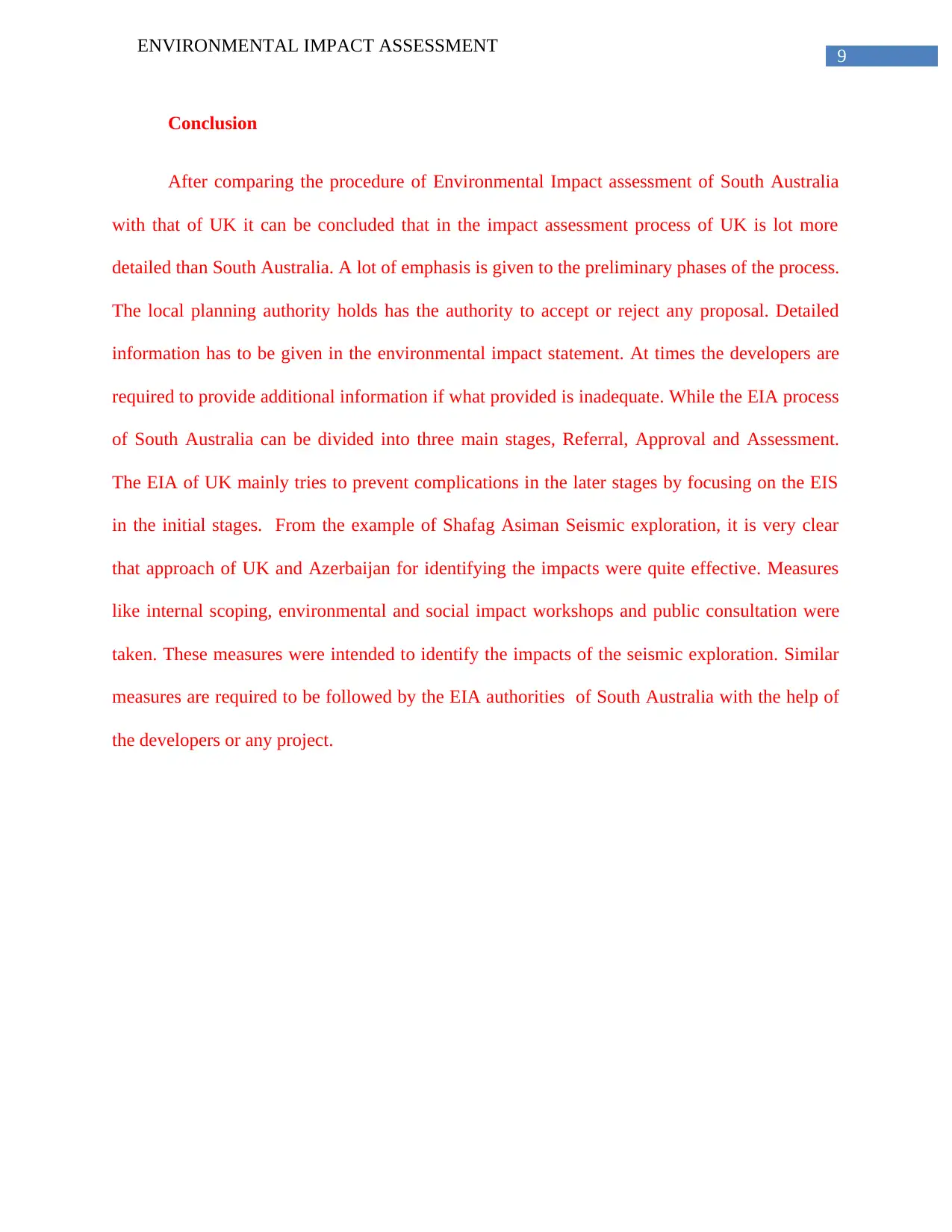
9
ENVIRONMENTAL IMPACT ASSESSMENT
Conclusion
After comparing the procedure of Environmental Impact assessment of South Australia
with that of UK it can be concluded that in the impact assessment process of UK is lot more
detailed than South Australia. A lot of emphasis is given to the preliminary phases of the process.
The local planning authority holds has the authority to accept or reject any proposal. Detailed
information has to be given in the environmental impact statement. At times the developers are
required to provide additional information if what provided is inadequate. While the EIA process
of South Australia can be divided into three main stages, Referral, Approval and Assessment.
The EIA of UK mainly tries to prevent complications in the later stages by focusing on the EIS
in the initial stages. From the example of Shafag Asiman Seismic exploration, it is very clear
that approach of UK and Azerbaijan for identifying the impacts were quite effective. Measures
like internal scoping, environmental and social impact workshops and public consultation were
taken. These measures were intended to identify the impacts of the seismic exploration. Similar
measures are required to be followed by the EIA authorities of South Australia with the help of
the developers or any project.
ENVIRONMENTAL IMPACT ASSESSMENT
Conclusion
After comparing the procedure of Environmental Impact assessment of South Australia
with that of UK it can be concluded that in the impact assessment process of UK is lot more
detailed than South Australia. A lot of emphasis is given to the preliminary phases of the process.
The local planning authority holds has the authority to accept or reject any proposal. Detailed
information has to be given in the environmental impact statement. At times the developers are
required to provide additional information if what provided is inadequate. While the EIA process
of South Australia can be divided into three main stages, Referral, Approval and Assessment.
The EIA of UK mainly tries to prevent complications in the later stages by focusing on the EIS
in the initial stages. From the example of Shafag Asiman Seismic exploration, it is very clear
that approach of UK and Azerbaijan for identifying the impacts were quite effective. Measures
like internal scoping, environmental and social impact workshops and public consultation were
taken. These measures were intended to identify the impacts of the seismic exploration. Similar
measures are required to be followed by the EIA authorities of South Australia with the help of
the developers or any project.
Paraphrase This Document
Need a fresh take? Get an instant paraphrase of this document with our AI Paraphraser
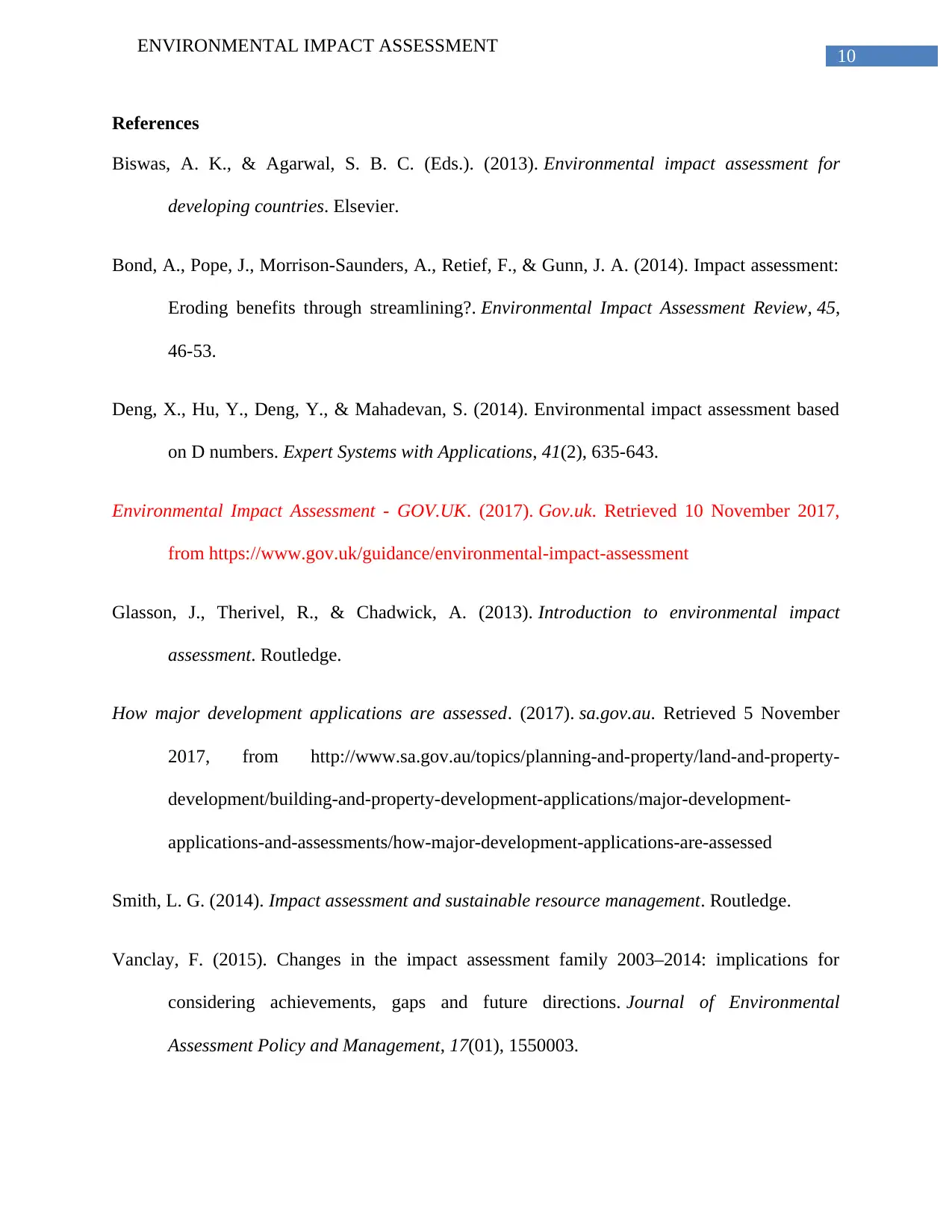
10
ENVIRONMENTAL IMPACT ASSESSMENT
References
Biswas, A. K., & Agarwal, S. B. C. (Eds.). (2013). Environmental impact assessment for
developing countries. Elsevier.
Bond, A., Pope, J., Morrison-Saunders, A., Retief, F., & Gunn, J. A. (2014). Impact assessment:
Eroding benefits through streamlining?. Environmental Impact Assessment Review, 45,
46-53.
Deng, X., Hu, Y., Deng, Y., & Mahadevan, S. (2014). Environmental impact assessment based
on D numbers. Expert Systems with Applications, 41(2), 635-643.
Environmental Impact Assessment - GOV.UK. (2017). Gov.uk. Retrieved 10 November 2017,
from https://www.gov.uk/guidance/environmental-impact-assessment
Glasson, J., Therivel, R., & Chadwick, A. (2013). Introduction to environmental impact
assessment. Routledge.
How major development applications are assessed. (2017). sa.gov.au. Retrieved 5 November
2017, from http://www.sa.gov.au/topics/planning-and-property/land-and-property-
development/building-and-property-development-applications/major-development-
applications-and-assessments/how-major-development-applications-are-assessed
Smith, L. G. (2014). Impact assessment and sustainable resource management. Routledge.
Vanclay, F. (2015). Changes in the impact assessment family 2003–2014: implications for
considering achievements, gaps and future directions. Journal of Environmental
Assessment Policy and Management, 17(01), 1550003.
ENVIRONMENTAL IMPACT ASSESSMENT
References
Biswas, A. K., & Agarwal, S. B. C. (Eds.). (2013). Environmental impact assessment for
developing countries. Elsevier.
Bond, A., Pope, J., Morrison-Saunders, A., Retief, F., & Gunn, J. A. (2014). Impact assessment:
Eroding benefits through streamlining?. Environmental Impact Assessment Review, 45,
46-53.
Deng, X., Hu, Y., Deng, Y., & Mahadevan, S. (2014). Environmental impact assessment based
on D numbers. Expert Systems with Applications, 41(2), 635-643.
Environmental Impact Assessment - GOV.UK. (2017). Gov.uk. Retrieved 10 November 2017,
from https://www.gov.uk/guidance/environmental-impact-assessment
Glasson, J., Therivel, R., & Chadwick, A. (2013). Introduction to environmental impact
assessment. Routledge.
How major development applications are assessed. (2017). sa.gov.au. Retrieved 5 November
2017, from http://www.sa.gov.au/topics/planning-and-property/land-and-property-
development/building-and-property-development-applications/major-development-
applications-and-assessments/how-major-development-applications-are-assessed
Smith, L. G. (2014). Impact assessment and sustainable resource management. Routledge.
Vanclay, F. (2015). Changes in the impact assessment family 2003–2014: implications for
considering achievements, gaps and future directions. Journal of Environmental
Assessment Policy and Management, 17(01), 1550003.

11
ENVIRONMENTAL IMPACT ASSESSMENT
Xia, T., Nitschke, M., Zhang, Y., Shah, P., Crabb, S., & Hansen, A. (2015). Traffic-related air
pollution and health co-benefits of alternative transport in Adelaide, South
Australia. Environment international, 74, 281-290.
ENVIRONMENTAL IMPACT ASSESSMENT
Xia, T., Nitschke, M., Zhang, Y., Shah, P., Crabb, S., & Hansen, A. (2015). Traffic-related air
pollution and health co-benefits of alternative transport in Adelaide, South
Australia. Environment international, 74, 281-290.
⊘ This is a preview!⊘
Do you want full access?
Subscribe today to unlock all pages.

Trusted by 1+ million students worldwide
1 out of 12
Related Documents
Your All-in-One AI-Powered Toolkit for Academic Success.
+13062052269
info@desklib.com
Available 24*7 on WhatsApp / Email
![[object Object]](/_next/static/media/star-bottom.7253800d.svg)
Unlock your academic potential
Copyright © 2020–2025 A2Z Services. All Rights Reserved. Developed and managed by ZUCOL.




